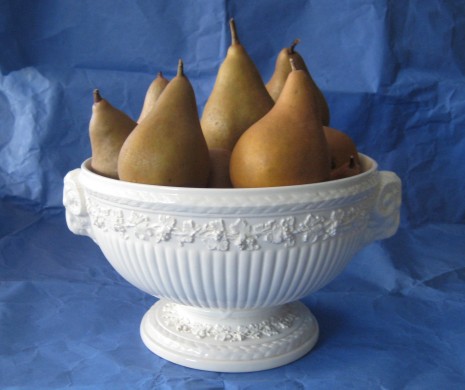PEARS: SHOPPING, COOKING, & EATING GUIDE
Pears are full of intrigue. Because they are usually rock-hard when you buy them, it’s difficult to gauge when they’ll be ready to eat and whether they’ll ultimately reward you with sweet, meltingly tender flesh. It’s no wonder that many shoppers pass them over for apples, which are immediately gratifying.
But some things, as we well know, are worth waiting for, and a ripe pear is one of them. This fruit is very efficient at ripening—or decaying, depending on how you look at it*. That’s why it needs to be harvested when mature but unripe. After resting in cold storage for a period of time, depending on the variety, it must finish ripening at room temperature. Personally, I never mind admiring their gorgeousness for the better part of a week. The anticipation is part of their ancient allure.
Figuring out when pears hit their prime can be tricky. Most varieties don’t signal their ripeness by changing color, but by yielding to gentle pressure around the neck, or stem end. I learned a great deal about pears from David Karp, a renowned fruit authority and former contributing editor at Gourmet. Ripening happens from the inside out, he explained, handing me a slice of Comice. “If you wait until they’re soft all over, they’ll be overripe—what the English call ‘sleepy.’ ” Once your pears are ripe, you can keep them in the fridge, but no longer than a few days.
If you’re like me, sometimes you’ve bought pears that have never gotten soft, period. That’s because they were held in cold storage too long. “They die, and never soften,” said David, who recently wrote an ode to the celebrated Warren pear for the L.A. Times. Because the Warren is such a finicky producer, it takes a fruit god—er, grower—like Al Courchesne of Frog Hollow Farm to make it more available. I’m especially happy about this, because it makes holiday shopping a breeze.
A quick recipe note: The brilliant thing about pears is that they don’t have to be ripe when you cook with them, so it’s not necessary to plan a pear tart or crumble days in advance. If you have ripe pears on hand, though, why mess with perfection? Serve them on your prettiest plates with a small, sharp knife and fork**. Put a generous wedge of farmstead Stilton on the table, and you have dessert and a cheese course at the same, with absolutely no effort at all.
A quick note on Asian pears: Unlike European-type varieties, Asian pears ripen on the tree and can be eaten straightaway. Varieties such as Shinseiki and 20th Century are famed for their juiciness and crunch. Russeted varieties like Hosui and Shinko are as sweet as candy. In Asia, pears aren’t cooked, but peeled and eaten fresh. Asian pears are sometimes called sand pears for their granular texture, due to a high concentration of thick-walled stone cells (sclereids).
Pears for Eating Out of Hand Bartlett, Bosc, Comice, Seckel, Warren, Asian pears; it’s customary to peel rough-skinned pears before eating.
Pears for Salads Asian pears, any firm-ripe European pears. Because pears begin to brown as soon as they’re sliced, toss them with some of the vinegar or lemon juice you’re using in the dressing.
Pears for Cooking Anjou comes into its own when baked in a pie or crumble; Comice bakes beautifully, too. Bosc and Seckel hold their elegant shape when poached in red or white wine, cider, or simple syrup.
Cheat Sheet to Pear Varieties***
Anjou (a.k.a. D’Anjou): First grown in France or Belgium in the 19th century, when it was known as Beurré d’Anjou, this plump, asymmetrical yellow-green pear is ubiquitous. Although it stores well and has tender, fine-textured flesh (it has a minimum of stone cells), its flavor is bland and not especially sweet.
Bartlett (a.k.a. Williams or Williams’ Bon Chrétien): You won’t find this variety in farmers markets now—it’s a summer pear and a poor keeper—but as it’s the most commonly grown pear in the United States and indeed the world, I thought it made sense to include it here. Golden and voluptuous, it has an enticing, musky aroma and flavor, as well as very juicy flesh.
Bosc: Developed in Belgium in 1807 as the Beurré Bosc, this russeted pear (see above photo) is as versatile in the kitchen as it is beautiful. Aromatic, rich-tasting, and syrupy, its dense, firm flesh melts in the mouth when ripe.
Comice (a.k.a. Doyenné du Comice): If you’ve ever received a Christmas box of exquisite pears with the trademarked name of Royal Riviera, you’re familiar with Comice. With smooth flesh and an almost winey flavor, this is one of the world’s great dessert pears.
Forelle: This small, very old variety isn’t ultrasweet, but I don’t care. I just discovered with deep delight that the word forelle means “trout” in German. That must be why the sight of this pear, splashed with red freckles that gradually spread into a vivid red blush, puts me in mind of the Victorian poet Gerard Manley Hopkins.
Highland: This lightly russeted yellow Bartlett-Comice cross, from Cornell’s New York State Agricultural Experiment Station, was introduced in 1974. A good keeper, it has juicy, slightly granular flesh and balanced flavor.
Potomac: Released by the USDA in 1993, this Anjou cross is small, light green, and glossy. A good keeper, it resembles its parent Anjou in flavor.
Red Pears: Most red pears are “sports,” or natural mutations of varieties such as Bartlett and Comice, grown primarily for their beauty. Flavor- and texture-wise, they generally resemble their green or yellow counterparts.
Seckel (a.k.a. Honey Pear, Sugar Pear): Discovered near Philadelphia in the late 1700s, this very small, fine-textured variety has great charm. Although it postdates Albrecht Dürer by more than 250 years, both the pear and the painting below share a complex, abiding sweetness.
* A conversation with culinary historian and former Gourmet contributing editor Anne Mendelson about the relative buoyancy of apples and pears (whoever heard of bobbing for pears?) led her to this little gem of a blogpost on rotting.
** You can find very nice sets of fruit knives and forks, some with mother-of-pearl or bone handles online. Throw in a box of Warren pears from Frog Hollow, and you have One Fabulous Present.
*** Among the purveyors at the Union Square Greenmarket, Terhune Orchards has marvelous pears this year. Earlier in the season, Samascott Orchards had the popular NY10346, bred at Cornell but never named; they’ve sold out for the season, but still have supplies of Bosc and Potomac. For market-day information, click here. Handsome color plates (technically, colorized photographs) of many of the varieties mentioned can be found in the peerless Pears of New York, by U.P. Hedrick and published by the New York Agricultural Experiment Station in 1921.
Posted: December 7th, 2011 under baking, Christmas, cooking, Gourmet magazine, people + places, Union Square Greenmarket.
Comments
Comment from admin
Time December 10, 2011 at 12:09 pm
That is a brilliant idea …. And so happy you wrote, for I love your shop and your fabulous curatorial eye. I first visited back in the late 80s, when I worked at Antiques magazine; I bought someone a wedding present that, in the end, I couldn’t just bear to part with! All good wishes, Jane
Comment from M. J.
Time November 2, 2013 at 1:19 pm
The NY10346 pear, which I call the zipcode pear, is my favorite. Fortunately I live near a greenmarket at which Samascott purveys these. A Samascott vendor told me that his is the only orchard which grows these. What a hidden culinary gem this is!




Comment from Kate Dyson
Time December 10, 2011 at 4:15 am
Lots of people eat fresh pears by cutting them lengthwise in quarters. I cut them in horizontal slices, not having taken the skin off. I find you don`t get such sticky fingers this way!
Your blog on pears is really interesting.